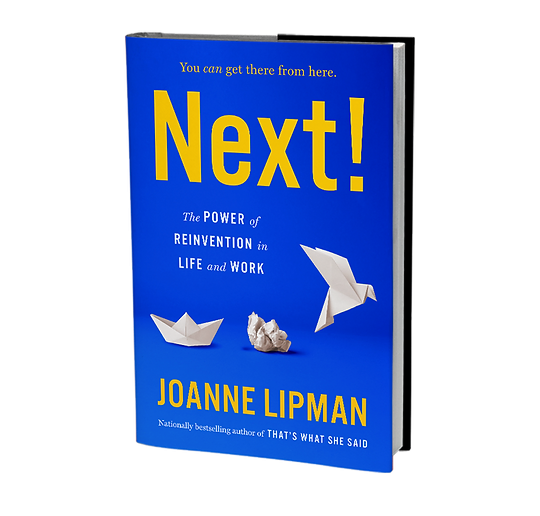My friend Joanne Lipman has had big jobs in print, including gigs at The Wall Street Journal and USA Today. After writing the bestselling book That’s What She Said about changing social norms in the workplace following the #MeToo movement, she’s focused her lens on how we can all reinvent ourselves— and lead more fulfilling lives — in her latest work, Next! The Power of Reinvention in Life and Work. Here’s our lightly edited conversation about what she discovered.
Katie Couric: Why did you want to write this book?
Joanne Lipman: Well, just for those who don’t know what Next! is, it’s a deeply reported guide to navigating change through the way that we live, work, and lead. And I wrote it for this moment in time. It taps right into what so many of us are feeling. We’re burned out. We’re looking for a more meaningful career or life. We’ve all been buffeted by this turmoil and tumult of the last three years, and we are looking for a new normal. We needed a guide, and I felt like there was no guide. I needed one, too. And that’s what I set out to write.
How did the pandemic impact your approach, and how do you think it’s changed the way we view careers?
It completely changed the way we view careers. I had an “a-ha” moment early on in the pandemic. I literally woke up in the middle of the night thinking, Oh my God, I don’t know where life is going from here. And not only that, nobody else does, right? That was the inspiration for the book. We all go through tumultuous periods of change. But during the pandemic we all started reprioritizing and rethinking our lives and our life choices.
In the book, you outline a “reinvention roadmap.” What exactly is that?
The first thing I did in my reporting was seek out people who had successfully gone through big transformations and asked them to walk me through how they had done it successfully — people who had changed careers, had these life-changing moments, who came back from failure, who came back from trauma. All different sorts of transformations. And then I spoke with experts who study each type of transformation.
There are psychologists who deal with trauma. There are neuroscientists who deal with “a-ha” moments in creativity. There are management gurus at Harvard Business School who deal with career change. I spoke to all these experts and mapped it out into four key steps: search, struggle, stop, solution.
Search is the first step — collecting information and experiences that will ultimately lead you to your reinvention. But the really cool thing is for most people, it’s unintentional. You’re collecting all this stuff and you have no idea that it’s going to lead you somewhere else.
Struggle is step two. This is where you are disconnecting from your previous life, but you have not quite figured out where you’re going. It’s really uncomfortable. We don’t like to talk about it. When we tell reinvention stories about people’s great transformations, we skip right over this. But it is actually the single most important part. It is when you feel like you’re stuck in the mud and everybody else has their act together except you. But in fact, during this struggle part, that’s where the important work gets done. You’re actually moving forward, even though you feel like you’re not.
That often does not end until you reach the third step, which is the stop. I quit my job, but this phase could also be something that is imposed on you, like you get fired, or there’s an illness or a terrible event that stops you in your tracks. It pulls you out of your routine and allows all of these previous experiences and thoughts and ideas that have been sort of percolating to coalesce.
And that is what leads you to that final step, which is your solution, your reinvention.
That sounds complicated.
It’s actually pretty simple. I talked to well-known household names, but also to regular, normal people.
For example, James Patterson, who we all know is the mega selling superstar author. I first met James Patterson more than 30 years ago. He was an ad executive, and I went to go interview him because he had the Burger King account, and I was writing about the Burger Awards. He said he had been up for hours because he really wanted to be a writer.
Fast forward 10 years, and suddenly I see him on TV holding up Along Came A Spider, this bestselling book. So I went back to James Patterson and I said, can you walk me through how you got from when I met you to where you are today? It was very much those four steps I talked about. The search was, while he was an ad executive, he was trying to write books and he was trying to find his voice and it was his search. Then he started getting published and his book started getting better.
He found his voice, then he’s in the struggle. His book started selling, but he was too afraid to leave. He went through several years of this struggle, and then he hit the stop, literally. He can pinpoint it for you. It was a summer Sunday, he’s coming back from the beach. He’s sitting on the Jersey Turnpike, stuck in standstill traffic. And he’s looking at the other side of the road where it’s just about empty, where the cars are going back to the beach on a Sunday night. And he said he had this a-ha moment when he said, “I’m on the wrong side of the road. I need to get to the other side of the road where I’m going back to the beach on a Sunday.” And that was the moment he quit and he became a full-time writer.
And that was his solution! Can anyone reinvent themselves?
First of all, it’s never too late. I interviewed people from their twenties to their nineties. You can do this at a young age, you can do this at an older age, but also you can do this multiple times in your life. I think one of the reasons the book is really relevant right now is because we’re in this period now where we’re now looking at a 60-year career as opposed to the 40-year career. Sixty years is a long time, and there is room for several different careers and reinventions along that timeframe.
And young people are going to have so many jobs by the time they retire.
If you look at millennials, their average time on a job is two years and nine months. For Gen Z, it’s two years, three months. So they will have quite a few jobs and careers. And by the way, they are more comfortable pivoting than their parents or boomers.
Have we fundamentally changed our attitudes about work? It does seem crazy that people in middle age are the ones who really put the pedal to the metal while they’re raising kids. They’re often expected to focus on work 24/7, and then when people get older and their kids are out of the house, they’re pushed out of the workforce.
I agree 100 percent. They fall off the ladder or they stall out, and yet they have so much energy and so much more to give.
And so much more time…
And time, right? Once your kids are grown, you’ve still got tons of energy, you’ve got all this experience. There’s a woman named Deborah O’Neill at Bowling Green State University, and she traces women’s career paths. She said it’s because so many women in particular reach a point where they’re squeezed off the ladder, they are ignored, they’ve hit the glass ceiling, they’re laid off — whatever, you name it — and they still have so much more to give. What’s really interesting is very often they go into more entrepreneurial careers.
Jane Veron, for example, has an MBA, is a super brilliant woman, had a good corporate job, and three daughters. She had to travel often for work and when her kids were babies, it was just too much to handle. She reluctantly quit and became a stay-at-home mom. She threw herself into community activities, the PTA, the zoning board. But when her oldest went off to college, Jane decided that she needed another chapter.
That was the moment where she realized she could not go back to that corporate career that she had left behind. Too much time had passed. Instead, she took everything she had learned during her 12 years at home and rolled it all up into a nonprofit where she recruited other moms who had quit big jobs to work with local small business owners. It became hugely successful and is called the Acceleration Project.
That raised her profile within her community of Scarsdale, New York. And she was then subsequently elected mayor. So she’s now mayor of Scarsdale. Jane says she tries to emphasize that when you’re in the middle of it, you have no idea where it’s going. And I thought that was such a great takeaway.
What’s the most important thing you learned writing this book?
My greatest piece of advice is to find your expert companion. I am borrowing that phrase from trauma psychologists who believe that one of the things that helps people to grow after experiencing trauma is to have this expert companion who could be a professional — like a therapist, but it could also be a friend or a relative who can reflect back to you. What are your strengths? What progress have you made?
It’s someone who sees you objectively. They’ll point out qualities or innate strengths that we either discount or we don’t even recognize in the first place because they’re so inborn to us that we don’t understand that they are something special and unique.
I may ask you to be mine, Joanne!
I would be delighted if you would be mine.










